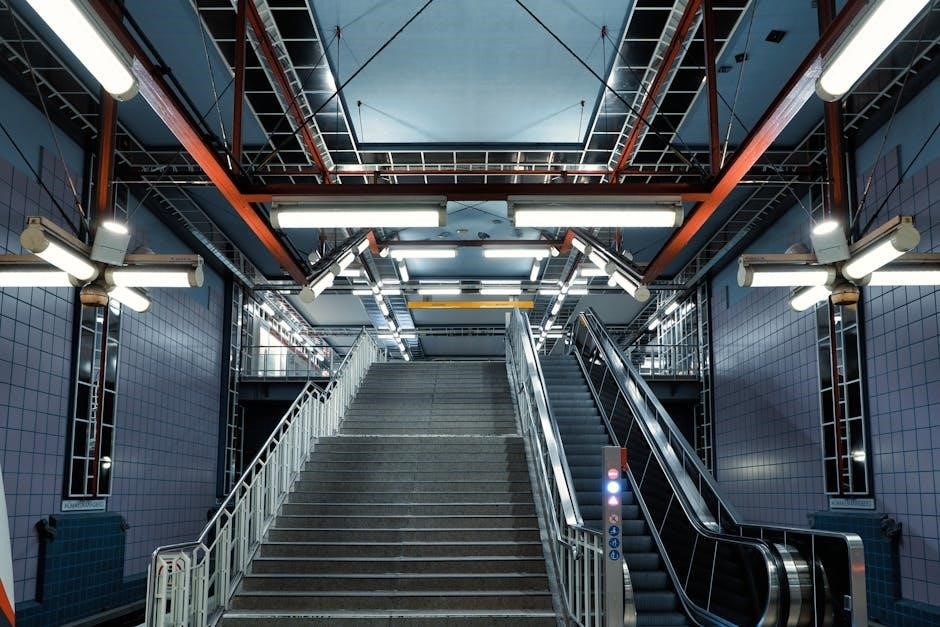S&G Safe Locks are renowned for their exceptional security features and durability, making them a popular choice among safe owners. They offer reliable protection for valuables, ensuring peace of mind with advanced locking mechanisms and user-friendly designs. Ideal for both residential and commercial use, these locks combine strength and convenience, providing a secure solution for safeguarding sensitive items.
1.1 Overview of S&G Safe Locks
S&G Safe Locks are high-security locking mechanisms designed to protect valuables stored in safes. Known for their durability and reliability, these locks are engineered to withstand tampering and unauthorized access. They are available in various types, including mechanical, digital, and biometric models, catering to different security needs. S&G locks are easy to install and program, offering features like combination settings, user codes, and time delay options. Their robust construction ensures long-term performance, making them a trusted choice for both residential and commercial safe owners. Proper installation and maintenance are essential to maximize their security benefits.
1.2 Importance of Proper Lock Installation
Proper installation of S&G Safe Locks is critical to ensure optimal security and functionality. Improperly installed locks can lead to security vulnerabilities, making it easier for unauthorized individuals to access the safe. A correctly mounted and aligned lock ensures smooth operation and prevents mechanical failures. Additionally, proper installation guarantees that all safety features, such as time delays or multiple-user codes, function as intended. Following the manufacturer’s guidelines is essential to maintain the integrity of the lock and protect the valuables stored inside. A well-installed lock also enhances durability, ensuring long-term reliability and security for your safe.

Types of S&G Safe Locks
S&G Safe Locks come in three primary types: Mechanical Combination Locks, known for their reliability; Electronic Digital Locks, offering modern convenience; and Biometric Locks, providing advanced fingerprint security.
2.1 Mechanical Combination Locks
Mechanical Combination Locks are a classic choice for S&G safes, offering reliability without the need for batteries. These locks typically feature a 3-wheel design, requiring a precise sequence of numbers to open. Known for their durability, they are resistant to tampering and provide a high level of security. The dial operates by turning right to the first number, continuing to the second, and stopping at the third to unlock. Their simplicity and robust construction make them a popular option for secure storage, ensuring long-lasting protection for valuables.
2.2 Electronic Digital Locks
Electronic Digital Locks offer advanced security and convenience for S&G safes. These locks use a keypad for code entry, eliminating the need for dial combinations. They often feature programmable master and user codes, allowing multiple access levels. Many models include a time delay option for added security. Battery-powered, they are easy to install and maintain. Low-battery alerts ensure uninterrupted access, and some locks offer override keys for emergencies. Their modern design and user-friendly interface make them ideal for those seeking a balance between security and ease of use, while maintaining the durability S&G is known for.
2.3 Biometric Locks
Biometric Locks are cutting-edge security solutions that use unique physical characteristics, such as fingerprints or facial recognition, to authenticate access. These locks eliminate the need for combinations or keys, offering unparalleled convenience and security. They are highly resistant to tampering and provide an additional layer of protection against unauthorized access. Biometric locks are ideal for users seeking advanced security measures without the hassle of remembering codes. They are also low-maintenance, requiring only occasional cleaning of the biometric sensor to ensure optimal performance. This modern technology seamlessly integrates with S&G safes, enhancing overall security and ease of use.

Installation Instructions
Proper installation ensures optimal functionality and security. Prepare the safe, mount the lock, and connect it to the mechanism. Test the lock post-installation.
3.1 Preparing the Safe for Lock Installation
Before installing an S&G safe lock, ensure the safe is empty and the door is fully open. Remove any obstructions and inspect the locking mechanism for damage. Clean the area where the lock will be mounted to ensure proper adhesion or fitment. If the safe has an electronic lock, check the battery compartment and replace batteries if necessary. Ensure all internal components are aligned and functioning correctly. Follow the manufacturer’s guidelines for preparing the safe, as improper preparation can lead to installation issues. Proper preparation ensures a smooth and secure installation process.
3.2 Mounting the Lock on the Safe
To mount the S&G lock on the safe, align the lock’s mounting holes with the pre-drilled holes on the safe door or frame. Use the manufacturer-provided template to ensure accurate placement. Secure the lock using the supplied screws, tightening them firmly but avoiding overtightening, which could damage the lock or safe. For electronic locks, connect the wiring harness to the safe’s mechanism according to the instructions. Double-check the alignment and ensure all screws are properly tightened. Test the lock’s functionality after installation to confirm it operates smoothly and securely.
3.3 Connecting the Lock to the Safe Mechanism
After mounting the lock, connect it to the safe’s internal mechanism. For mechanical locks, insert the spindle into the locking mechanism and secure it with the provided clip or screw. For electronic locks, attach the wiring harness to the safe’s control panel or boltwork. Follow the manufacturer’s wiring diagram to ensure proper connections. Test the lock by entering the combination or using the override key to confirm the mechanism engages and disengages correctly. If the lock does not respond, double-check all connections and refer to the troubleshooting guide in the manual.

Programming the Lock
Programming the lock involves setting the master combination and user codes. Open the safe, enter the current code, and follow the manufacturer’s instructions to reset or update codes. Ensure the door is open during programming to avoid locking yourself out. Test the new combination immediately to confirm it works correctly. Always refer to the manual for specific steps and security guidelines.
4.1 Setting the Master Combination
Setting the master combination is the first step in programming your S&G safe lock. Open the safe and enter the default combination provided by the manufacturer. Once accessed, locate the combination change process in the manual. Enter the new master combination, ensuring it is unique and secure. Confirm the change by following the lock’s verification steps. Test the new combination immediately to ensure it works correctly. Remember to store the master combination in a safe place, as it grants full access to the lock. Always keep it confidential to maintain security.
4.2 Creating User Codes
Creating user codes allows multiple individuals to access the safe while maintaining security. After setting the master combination, enter the programming mode by following the lock’s specific instructions. Input the new user code, ensuring it meets the required length and complexity. Confirm the code by re-entering it or following the lock’s verification process. Store the user codes securely and share them only with trusted individuals. Regularly review and update user codes to maintain optimal security. If a code is no longer needed, delete it to prevent unauthorized access. Always prioritize confidentiality when managing user codes.
4.3 Resetting the Default Combination
Resetting the default combination on your S&G safe lock restores it to factory settings, ensuring a fresh start for security. Open the safe door and locate the reset button or mechanism, typically inside. Enter the current combination or use the override key if necessary. Follow the lock’s instructions to input a new combination, ensuring it’s unique and secure. Confirm the reset process by locking and unlocking the safe to test the new combination. Keep the new code confidential and store it safely. Resetting is ideal when transferring ownership or upgrading security measures. Always verify the reset process in your lock’s manual for specific steps.
Operating the Lock
Operating the S&G safe lock involves entering the combination, locking, and unlocking. Ensure smooth operation by following the correct sequence for dialing or keypad entry. Always test functionality after changes to confirm reliability and security.
5.1 Entering the Combination
To enter the combination on an S&G safe lock, ensure the dial is set to “0.” Turn the dial right, stopping at the first number. Continue turning right for the second number, then left for the final number. Align the last number with the arrow. For digital locks, simply key in the code. Always test the combination after programming to ensure it works correctly. If using a biometric lock, place your fingerprint or scan as instructed. Proper entry ensures smooth operation and secure access to your safe.
5.2 Locking and Unlocking the Safe
To unlock the safe, enter the correct combination following the lock’s specific instructions. For mechanical locks, turn the dial to align numbers precisely. Digital locks require keying in the code, while biometric locks use fingerprint or scan authentication. Once unlocked, open the door carefully. To lock, close the door and ensure it clicks shut. Digital locks may require pressing a button to engage. Always test the combination after programming. Keep the door open during programming to avoid accidental locking. Proper locking ensures security and prevents unauthorized access. Regular testing guarantees smooth operation.
5.4 Using the Time Delay Feature
The time delay feature enhances security by delaying the unlocking process. Activate it via the master code in the lock’s settings. Set a delay duration (e.g., 15 minutes) to deter unauthorized access. After entering the correct combination, the lock will unlock only after the delay expires. This feature is ideal for high-security situations. Ensure the door is open when programming the delay to avoid locking yourself out. Use the override code to bypass the delay in emergencies. Regularly test the feature to ensure proper function and adjust the delay as needed for optimal security and convenience.

Troubleshooting Common Issues
Identify common issues like forgotten combinations, battery depletion, or jammed mechanisms. Follow specific recovery and replacement procedures to resolve these problems efficiently and restore access.
6.1 Forgotten Combination Recovery
If you’ve forgotten your combination, start by checking if you have a master key or override code. If not, contact a locksmith experienced with S&G locks.
For mechanical locks, turn the dial right, stopping when the middle wheel moves and aligns with the gate. Note the number and test it. Avoid force to prevent damage.
For digital locks, use the override code or replace the battery. Regularly test your combination and document it securely to avoid future issues.
6.2 Battery Replacement for Digital Locks
To replace the battery in your S&G digital lock, ensure the safe is unlocked to avoid being locked out. Open the battery compartment, usually located at the back or bottom of the lock. Remove the old battery and insert a new one of the recommended type (refer to your manual). Close the compartment and test the lock to confirm it’s functioning properly. Replace batteries every 2-3 years or when the low-battery indicator appears. Keep a spare battery on hand to prevent access issues.
6.3 Jammed or Stuck Lock Mechanism
If your S&G digital or mechanical lock becomes jammed, avoid forcing the dial, as this can cause further damage. Instead, clean the lock and mechanism to remove dirt or debris. Lightly spray silicone-based lubricant on moving parts to ensure smooth operation. If the issue persists, contact a professional locksmith experienced with safe locks. Regular maintenance and lubrication can prevent such problems. Always refer to your manual for specific guidance on handling a stuck mechanism to avoid compromising the lock’s security features.

Maintenance and Care
Regular cleaning and lubrication of moving parts ensure smooth operation. Use a soft cloth to wipe surfaces and apply silicone-based lubricant sparingly. Avoid excessive oil, as it may attract dust. Clean the keypad and dial regularly to prevent debris buildup. Test the lock mechanism periodically to ensure proper function. Proper maintenance extends the lifespan and reliability of your S&G safe lock, safeguarding your valuables effectively.
7.1 Cleaning the Lock
Cleaning is essential for maintaining the functionality of your S&G safe lock. Use a soft, dry cloth to wipe down the exterior and remove dust or debris. For electronic locks, gently clean the keypad with a slightly damp cloth, avoiding moisture seepage. Mechanical locks require attention to the dial and spindle—use a clean, dry brush to remove grime. Avoid harsh chemicals or abrasive materials that could damage finishes. Regular cleaning prevents dust buildup and ensures smooth operation; For biometric locks, clean the fingerprint sensor with an alcohol-free wipe to maintain accuracy. Consistent maintenance keeps your lock performing reliably and securely.

7.2 Lubricating Moving Parts
Lubricating moving parts of your S&G safe lock ensures smooth operation and prevents wear. For mechanical locks, apply a small amount of silicone-based spray lubricant to the dial and spindle every 6-12 months. Avoid oil-based products, as they can attract dust. For electronic locks, lubrication is typically not needed, but cleaning the keypad and hinges with a dry cloth is recommended. Over-lubrication can damage internal components, so use sparingly. Regular lubrication maintains lock efficiency and extends its lifespan. Always test the lock after lubrication to ensure proper function. Consult the user manual or contact a locksmith if unsure.
7.3 Regular Testing of the Lock
Regular testing of your S&G safe lock ensures optimal performance and security. Start by entering the combination multiple times to confirm smooth operation. Check the locking mechanism by closing the safe and attempting to open it without entering the code. For electronic locks, test the keypad response and ensure all user codes function correctly. If equipped, verify the time delay feature activates and deactivates properly. Avoid over-testing, as excessive use can wear down components. Perform these checks every 2-3 months and after any maintenance. If issues arise, contact a professional locksmith for assistance. Regular testing ensures your lock remains reliable and secure.

Security Best Practices
Secure your safe in an inconspicuous location to prevent tampering. Always keep combinations confidential and update security features regularly. Consult a locksmith for complex setups to ensure maximum protection.
8.1 Choosing a Secure Location for the Safe
Selecting the right location for your S&G safe is crucial for maximizing security. Opt for a spot that is not easily visible or accessible to unauthorized individuals. Anchoring the safe to the floor or wall prevents theft or removal. Avoid placing it in high-traffic areas or near windows to reduce vulnerability. Consider a location that blends into the surroundings, such as a closet or behind a decorative panel. Ensure the safe is installed in a way that allows easy access for authorized users while maintaining discretion. Proper placement enhances both security and convenience.
8.2 Keeping the Combination Confidential
Maintaining the confidentiality of your S&G safe combination is essential to ensure maximum security. Avoid sharing the combination with unauthorized individuals, even if they are trusted. Store the combination in a secure, separate location, such as a locked drawer or a safe deposit box. Never write it down in an easily accessible place or share it digitally without encryption. Regularly review and update user codes to prevent unauthorized access. Use multi-layered security measures, such as biometric locks or two-factor authentication, to add an extra layer of protection. Remember, the safest combination is one known only to authorized users.
8.3 Updating Security Features
Regularly updating your S&G safe lock’s security features ensures optimal protection against evolving threats. For digital locks, check for firmware updates that enhance functionality or patch vulnerabilities. Enable multi-factor authentication for added layers of security. Consider upgrading to biometric locks for advanced verification methods. Stay informed about the latest security advancements and best practices. Updating your lock’s software and hardware keeps your valuables safe from potential breaches. Always follow the manufacturer’s guidelines for updates to maintain compatibility and performance.

Emergency Unlocking Procedures
In emergencies, use the override key or contact a locksmith. Some locks offer a time delay override code for quick access. Always act carefully to avoid damage.
9.1 Using the Override Key
Using the override key is a reliable emergency unlocking method. Ensure the safe door is accessible. Insert the key into the override keyhole, typically located near the combination dial. Turn the key clockwise to activate the unlocking mechanism. Once the lock disengages, the safe door will open. After accessing your valuables, reset the lock by turning the dial to the closed position. Store the override key securely to prevent unauthorized access. This feature ensures quick entry when the primary locking method fails, providing peace of mind during emergencies.
9.2 Contacting a Professional Locksmith
Contacting a professional locksmith is a reliable emergency solution when you cannot access your safe. Identify a locksmith experienced with S&G locks to ensure expertise. Look for reputable services with positive reviews to avoid potential scams. Provide the locksmith with detailed information about your lock type and issue for a quick resolution. They will assess the situation, use specialized tools, and restore access without damaging the safe. Always verify the locksmith’s credentials before allowing them to work on your safe. This ensures your valuables remain secure throughout the process. A professional locksmith is the best option for resolving complex locking issues safely and efficiently.
9.3 Using the Time Delay Override Code
The time delay override code is a convenient feature for accessing your safe during the delay period. Enter the override code when the safe is locked but the delay hasn’t expired. This code bypasses the waiting time, allowing immediate access. Ensure the code is entered correctly to avoid additional delays. Once entered, the safe will unlock, and the delay feature will reset. Note that this feature does not disable the delay permanently; it only provides temporary access. Always refer to your safe’s manual for specific instructions on using the override code effectively without causing damage to the locking mechanism.
Upgrading Your Lock
Upgrading your S&G lock enhances security and functionality. Assess current needs, replace outdated components, and integrate new features. Ensure compatibility and follow instructions carefully to maintain performance.

10.1 When to Upgrade Your Lock
Upgrade your S&G lock when outdated technology compromises security or performance. Consider upgrading if your lock shows signs of wear, has outdated features, or fails to meet modern security standards. If you experience frequent malfunctions or battery issues with digital locks, it may be time to upgrade. Additionally, if your security needs evolve, such as requiring advanced biometric features or improved anti-theft measures, upgrading ensures your valuables remain protected. Regularly assess your lock’s condition and functionality to determine if an upgrade is necessary for optimal performance and peace of mind.
10.2 Steps to Upgrade to a New Lock
Upgrading your S&G lock involves several key steps to ensure a smooth transition. First, assess your current lock’s compatibility and security needs. Next, purchase a new lock that aligns with your requirements. Disconnect the old lock from the safe’s mechanism, following the manufacturer’s instructions. Install the new lock, ensuring proper alignment and secure mounting. Transfer any existing settings, such as user codes or time delays, to the new lock. Finally, test the lock thoroughly to confirm it operates correctly. Always refer to the manufacturer’s guide for specific instructions tailored to your S&G lock model.
10.3 Transferring Settings to a New Lock
Transferring settings to a new S&G lock ensures continuity and convenience. Start by documenting your current lock’s master combination, user codes, and any custom settings like time delays. Access the new lock’s programming mode, typically by entering the default or override code. Input the master combination and user codes exactly as before. For advanced features, such as time delays, follow the lock’s specific programming sequence. Finally, test all settings to ensure they function correctly. Always refer to the manufacturer’s instructions for detailed guidance tailored to your S&G lock model. This ensures your security preferences are seamlessly transitioned.
